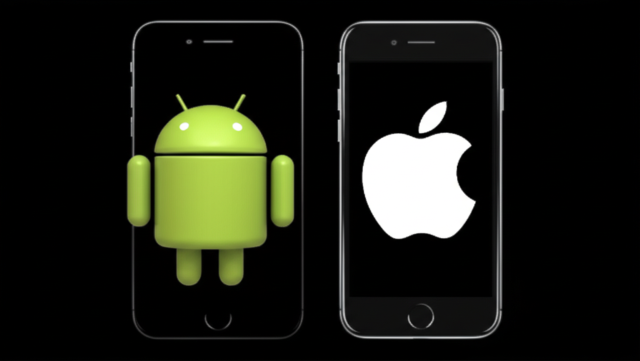
Android vs iPhone: Which Smartphone Reigns Supreme?
The smartphone market is dominated by two major players: Android and iPhone. Choosing between the two can feel like navigating a minefield of technical jargon and subjective opinions. This comprehensive guide aims to simplify the decision-making process by breaking down the key differences between these two mobile operating systems, helping you determine which best suits your needs and preferences.
Operating System: The Core Difference
At the heart of the Android vs. iPhone debate lies the operating system (OS). Android, developed by Google, is an open-source platform used by numerous manufacturers like Samsung, Google, OnePlus, and Xiaomi. This open nature allows for extensive customization and a wide range of devices at various price points. iPhone, on the other hand, runs on iOS, a closed-source operating system developed and exclusively used by Apple. This closed ecosystem offers a more tightly controlled and often considered simpler user experience.
User Interface and Experience
Android's user interface is known for its flexibility. Manufacturers often customize the Android experience, resulting in variations in look and feel across different brands. This can lead to a more personalized experience, but might also mean inconsistencies across devices. iOS, with its intuitive design and consistent user experience across all iPhones, provides a simpler, more predictable interface. Many users find the iOS interface easier to navigate, especially those new to smartphones.
Customization Options
Android's open-source nature shines when it comes to customization. Users can personalize almost every aspect of their phone, from widgets and launchers to icon packs and notification settings. This high degree of freedom allows for a truly unique mobile experience. iOS, while offering some customization options, is significantly more restrictive. Apple prioritizes a consistent user experience across all devices, limiting the scope of customization available to users.
App Ecosystem: A World of Apps
Both Android and iOS boast massive app stores – the Google Play Store and the Apple App Store, respectively. While both offer a vast selection of apps, there are subtle differences. The Google Play Store generally has a broader selection of apps and games, often including more niche or less-popular applications. The Apple App Store, while smaller, tends to have a higher standard of app quality due to Apple's stricter app review process. This often leads to fewer buggy or malicious apps on iOS compared to Android.
App Availability and Compatibility
Generally, most popular apps are available on both platforms. However, there are instances where an app may be exclusive to one platform or the other. Some developers may choose to focus on one OS due to factors like development costs or target audience. It's always recommended to check the availability of your essential apps before making a decision.
Hardware and Price: A Spectrum of Choices
Android's open-source nature extends to its hardware. A wide variety of manufacturers produce Android phones, resulting in a broad spectrum of prices and features. You can find budget-friendly Android phones with decent specifications as well as high-end flagships that compete with the best iPhones. Apple, on the other hand, focuses on a smaller range of devices within a narrower price range. Generally, iPhones tend to be positioned at the higher end of the market, although more affordable options like the iPhone SE exist.
Device Variety and Specifications
Android offers a much wider array of device choices. Different manufacturers offer unique designs, features, and specifications, catering to diverse user needs and preferences. This diversity means you'll likely find an Android phone that perfectly matches your requirements, whether it's a large screen, a long battery life, or advanced camera capabilities. Apple offers less device variation, typically sticking to a few model sizes each year with consistent design language.
Security and Privacy: A Crucial Consideration
Both Android and iOS prioritize security and privacy, but they employ different approaches. Apple's closed ecosystem and tighter control over its software and hardware contribute to a reputation for robust security. iOS updates are rolled out swiftly and consistently across all supported devices, ensuring that users benefit from the latest security patches. Android, being more fragmented due to its open nature, can experience delays in receiving security updates, particularly for older devices or those manufactured by lesser-known brands. However, Google has made significant improvements in recent years to address this fragmentation issue.
Data Privacy and User Control
Both platforms offer various privacy settings, allowing users to control the data they share with apps and services. Apple has positioned itself as a champion of user privacy, often highlighting its commitment to data protection in its marketing. Android, while not lagging far behind, has been criticized in the past for certain data collection practices. However, Google has implemented significant changes to improve transparency and user control over their data.
Updates and Support: Staying Current
iOS devices generally receive software updates for a longer period than most Android devices. Apple is renowned for supporting its devices with updates for several years, ensuring users have access to the latest features and security patches. Android update timelines vary greatly depending on the manufacturer and device model. Some manufacturers offer timely updates, while others lag considerably behind. This inconsistency can be a significant drawback for Android users who want to stay current with the latest software features and security improvements.
Which Smartphone is Right for You?
The "best" smartphone ultimately depends on your individual needs and priorities. Here's a quick summary to help guide your decision:
Choose Android if:
- You want a wide range of devices at various price points.
- You value extensive customization options.
- You need a large selection of apps and games.
- You want more control over your device's appearance and functionality.
Choose iPhone if:
- You prefer a simple, intuitive user interface.
- You prioritize a consistent user experience across devices.
- You value a seamless integration between your devices.
- You want a robust and secure operating system with timely updates.
- You prefer a premium device with excellent build quality.
Ultimately, the decision is yours. Consider your budget, your technical expertise, your desired level of customization, and your priorities regarding security and updates. Researching specific models within each ecosystem will help you narrow down your choices and find the perfect smartphone for your needs.

